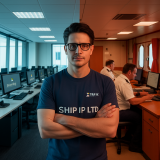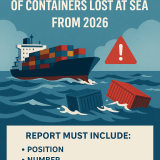Today, the CMA CGM Group, a global player in sea, land, air and logistics solutions, in partnership with Infinity Logistics and Transport Ventures Limited (Infinity), flagged-off a weekly Penang-Padang Besar block train service; and officially opened a container depot in the Penang Port.

Up to 100 containers on rail are dedicated for CMA CGM shippers each week
With the launch of the Penang-Padang Besar block train service, CMA CGM is providing a rail and sea multimodal solution to exporters from the southern provinces of Thailand who ship their cargo through the Penang Port.
Each week, up to 100 containers on rail are dedicated for CMA CGM shippers. Laden containers are picked up from Padang Besar, a Malaysian town on the border with the Songkhla province of Thailand. They will then set off for the Penang Port to be loaded on the CMS2 and KCM2 services provided by CNC, the CMA CGM Group’s Intra-Asia specialist. From Penang, the two weekly services will head for Malaysia’s top export destinations in Asia including Singapore, Hong Kong, Shanghai, Qingdao, and Busan.
Designed to go the extra mile for customers with CMA CGM as a one-stop service provider, the multimodal offering secures them equipment as well as rail and sailing slots; reduces their customs, monitoring and transportation costs; and saves them on scheduling activities with different providers.

A depot with specialised container handling capabilities
The block train service will make its weekly stop in the Penang port, adjacent to the newly opened on- dock depot that occupies over 14,000 sqm in land area. Co managed by CMA CGM and Infinity, the depot is characterised by better connectivity coupled with diverse container handling capabilities and efficiency.
With a monthly operating capacity of 7,500 (TEU) containers, the facility provides more than just container storage, repair, cleaning, washing, handling and pre-trip inspections. It also specializes in handling CONTAINER Grade Selection – a container solution for special goods – as well as Flexitank containers for non-dangerous liquid shipments such as cooking oil that Penang exports.
This new facility in Penang is the CMA CGM Group’s third depot in Malaysia, and complements the Group’s depot footprint in addition to two others in West Port and North Port in Port Klang.
The block train option significantly reduces CO2 emissions, and this new service is part of the CMA CGM Group’s commitment to develop BETTER WAYS to act for more sustainable, efficient, and fluid transport solutions.
YAB Mr. Chow Kon Yew, Chief Minister of Penang said, “Congratulations to both CMA CGM and Infinity on this great partnership, it will certainly further reinforce Penang as a dynamic import and export gateway of Malaysia’s northern region – the Silicon Valley of the East. In line with the Penang2030 plan, I also believe that this partnership will help strengthen Penang Port as a prominent logistics hub, subsequently becoming a preferred destination of investments in ASEAN.”
Ravindra Sahu, Managing Director of CMA CGM Malaysia said,“The CMA CGM Group is delighted to have partnered Infinity in launching a compelling block train service and opening a depot here with strong support from the Penang Port. They are important milestones that enable us to streamline our customers’ logistics needs as we seamlessly relay their cargo from point to point. At CMA CGM, we are continuously identifying BETTER WAYS to enrich and enhance our value proposition to our customers, partners and key stakeholders.”
Dato’ Sasedharan Vasudevan, Chief Executive Officer of Penang Port Sdn Bhd said “Being a multipurpose port, Penang Port Sdn Bhd certainly has multiple advantages that can support the vision of CMA CGM Group and Infinity’s block train service and container depot. After the launching, the container depots in Penang Port will be one of the busiest places to come across. The design of our layout and area provides sufficient space for storage and it also promotes high-level security which will be crucial for both CMA CGM and Infinity. That is not all, as part of Penang Port’s masterplan, our current phase of expansion within the NBCT put emphasis on land reclamation, among those are focused on expanding our logistics warehousing efforts. Moreover, plans for the new gates will allow for our future volume growth – coupled with our berth expansion that allows us to cater about 2.2 million TEUs in our container yard in the coming years. This will surely provide a significant space to support CMA CGM Group and Infinity’s block train service and container depot, as well as all of our key partners within the terminal. Penang Port is delighted to begin this exciting new venture with CMA CGM & Infinity.”









